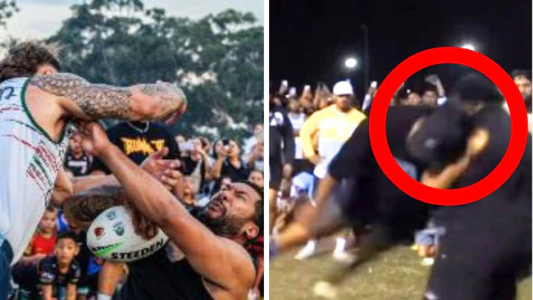'This is insanity': Neuroscientist sounds alarm over new Aussie sport
By
Maan
- Replies 11
What started as a playground dare has evolved into something far more intense—and far more dangerous.
A viral trend rooted in toughness and bravado is now being packaged as a full-contact sport, drawing big names and even bigger risks.
But behind the hype, experts are sounding the alarm over what this new competition could mean for the future of athlete safety.
What once echoed across footy fields and schoolyards as a test of courage has now been repackaged as a full-blown contact sport.
The phrase ‘run it straight’, deeply embedded in rugby league culture, originally encouraged players to charge full-speed into a tackle without flinching.
Over time, this dare morphed into a viral trend on social media, with clips of full-throttle collisions drawing millions of views.
Now, two groups—‘Run it Straight Official’ and ‘RUNIT Championship League’—took it to the next level by creating a competitive format and turning it into a business.
RUNIT launched its first official contest with a $4000 prize for the winner, boasting a line-up of former athletes and amateur brawlers.
Promotional footage showed competitors sprinting along a 10-metre grassy strip, taking turns to either bowl over or bring down their opponent using pure force.
The sport’s aim wasn’t finesse or strategy—it was domination through impact.
If neither player was knocked out after four rounds, judges selected the winner based on who inflicted the most damage.
Melbourne Storm's Nelson Asofa-Solomona fronted the campaign and declared in a YouTube promo: ‘Welcome to RUNIT, this is where we separate the strong from the stronger.’
‘If you’re running the job is simple, you run it straight,’ he continued.
‘So how do you win? You win by dominating contact.’
‘Hit hard, stand your ground and inflict damage...This is a sport built for warriors with the mental game, technique and strength to step up and run it.’
The creators believed the format could rival the likes of the UFC, drawing comparisons to the World Arm Wrestling League and Power Slap.
Co-founders Rennie Molimau and Virgil Tauaa spoke about the vision, saying the quick-hitting format was tailored to today’s shorter attention spans.
‘Fans should expect a jam-packed, action-packed night, it’ll be one to remember,’ Molimau shared.
Tauaa added: ‘It’s a test of strength, but ego and pride do come into it …otherwise it’s just a fun game to play.’
He said growing up in the Pacific Islander community, the ‘run it straight’ challenge was just part of life.
‘We played it as kids growing up, now fast forward all these years, people’s attention span is decreasing and some people find it harder to sit through an 80-minute game of rugby league.’
‘Fans come for the big collisions and big runs.’
Want to see the action for yourself? Check out the video linked below for a closer look at the chaos unfolding in this new sport.
Source: Youtube/Charizma68
But while it might thrill some spectators, others were left horrified.
Dr Alan Pearce, one of Australia's top sports neuroscientists, warned of serious long-term health consequences.
‘I was pretty gobsmacked, speechless actually when I saw this competition idea starting because for me as someone who has seen hundreds of footballers and rugby league players who are now struggling with brain injury and long-term impairment it is really troubling,’ he shared.
He labelled the sport ‘insanity’ and criticised the glorification of heavy collisions for entertainment.
‘I just cannot understand how they could take the most violent aspect of sport and just turn it into a spectacle where the objective is just to try and knock out or hurt your opponent.’
‘In a lot of these other sports (such as NRL, AFL and rugby union) you’re trying to avoid direct contact whereas this is purely running at each other, it’s insanity.’
Dr Pearce argued that many participants likely had a background in contact sport and may already have had repeated head knock: ‘A lot of these people competing have a footy background and if anything it’s worse as they have already likely had several head knocks which add up a lot quicker than people realise.’
He suggested some were drawn to the sport by the false belief that rugby and AFL had become soft: ‘Then there’s the idea that (contact) sport is getting soft. But that’s incorrect, it is actually getting far harder as the athletes are now bigger, stronger and faster than ever before, just look at the injury lists every week.’
‘We are seeing at all levels of the game higher injury rates but yet people are still complaining that sports are getting soft because we’re trying to crack down on things that are causing damage to our brains and bodies.’
‘So to them, I’d say you look at the evidence first before making comments around the game getting soft. We’re just basically trying to be more responsible in looking after our athletes as they are not just commodities.’
Despite its critics, RUNIT claimed it had implemented strict safety procedures, including pre- and post-hit medical assessments.
But when the criteria for winning focused on ‘damage’, safety seemed a hard promise to deliver.
High-profile names like Jamarra Ugle-Hagan and George Burgess jumped on board to support the launch, calling it ‘must watch’ sport.
Burgess faced off against former Super Rugby powerhouse Nemani Nadolo in an exhibition match ahead of the main event.
Following the Melbourne debut, the competition was set to travel to New Zealand on 25 May, with plans to hit the United States, Saudi Arabia and England later in the year.

With the increasing popularity of these intense competitions, do you think the thrill is worth the risk? Share your thoughts in the comments below!
A viral trend rooted in toughness and bravado is now being packaged as a full-contact sport, drawing big names and even bigger risks.
But behind the hype, experts are sounding the alarm over what this new competition could mean for the future of athlete safety.
What once echoed across footy fields and schoolyards as a test of courage has now been repackaged as a full-blown contact sport.
The phrase ‘run it straight’, deeply embedded in rugby league culture, originally encouraged players to charge full-speed into a tackle without flinching.
Over time, this dare morphed into a viral trend on social media, with clips of full-throttle collisions drawing millions of views.
Now, two groups—‘Run it Straight Official’ and ‘RUNIT Championship League’—took it to the next level by creating a competitive format and turning it into a business.
RUNIT launched its first official contest with a $4000 prize for the winner, boasting a line-up of former athletes and amateur brawlers.
Promotional footage showed competitors sprinting along a 10-metre grassy strip, taking turns to either bowl over or bring down their opponent using pure force.
The sport’s aim wasn’t finesse or strategy—it was domination through impact.
If neither player was knocked out after four rounds, judges selected the winner based on who inflicted the most damage.
Melbourne Storm's Nelson Asofa-Solomona fronted the campaign and declared in a YouTube promo: ‘Welcome to RUNIT, this is where we separate the strong from the stronger.’
‘If you’re running the job is simple, you run it straight,’ he continued.
‘So how do you win? You win by dominating contact.’
‘Hit hard, stand your ground and inflict damage...This is a sport built for warriors with the mental game, technique and strength to step up and run it.’
The creators believed the format could rival the likes of the UFC, drawing comparisons to the World Arm Wrestling League and Power Slap.
Co-founders Rennie Molimau and Virgil Tauaa spoke about the vision, saying the quick-hitting format was tailored to today’s shorter attention spans.
‘Fans should expect a jam-packed, action-packed night, it’ll be one to remember,’ Molimau shared.
Tauaa added: ‘It’s a test of strength, but ego and pride do come into it …otherwise it’s just a fun game to play.’
He said growing up in the Pacific Islander community, the ‘run it straight’ challenge was just part of life.
‘We played it as kids growing up, now fast forward all these years, people’s attention span is decreasing and some people find it harder to sit through an 80-minute game of rugby league.’
‘Fans come for the big collisions and big runs.’
Want to see the action for yourself? Check out the video linked below for a closer look at the chaos unfolding in this new sport.
Source: Youtube/Charizma68
But while it might thrill some spectators, others were left horrified.
Dr Alan Pearce, one of Australia's top sports neuroscientists, warned of serious long-term health consequences.
‘I was pretty gobsmacked, speechless actually when I saw this competition idea starting because for me as someone who has seen hundreds of footballers and rugby league players who are now struggling with brain injury and long-term impairment it is really troubling,’ he shared.
He labelled the sport ‘insanity’ and criticised the glorification of heavy collisions for entertainment.
‘I just cannot understand how they could take the most violent aspect of sport and just turn it into a spectacle where the objective is just to try and knock out or hurt your opponent.’
‘In a lot of these other sports (such as NRL, AFL and rugby union) you’re trying to avoid direct contact whereas this is purely running at each other, it’s insanity.’
Dr Pearce argued that many participants likely had a background in contact sport and may already have had repeated head knock: ‘A lot of these people competing have a footy background and if anything it’s worse as they have already likely had several head knocks which add up a lot quicker than people realise.’
He suggested some were drawn to the sport by the false belief that rugby and AFL had become soft: ‘Then there’s the idea that (contact) sport is getting soft. But that’s incorrect, it is actually getting far harder as the athletes are now bigger, stronger and faster than ever before, just look at the injury lists every week.’
‘We are seeing at all levels of the game higher injury rates but yet people are still complaining that sports are getting soft because we’re trying to crack down on things that are causing damage to our brains and bodies.’
‘So to them, I’d say you look at the evidence first before making comments around the game getting soft. We’re just basically trying to be more responsible in looking after our athletes as they are not just commodities.’
Despite its critics, RUNIT claimed it had implemented strict safety procedures, including pre- and post-hit medical assessments.
But when the criteria for winning focused on ‘damage’, safety seemed a hard promise to deliver.
High-profile names like Jamarra Ugle-Hagan and George Burgess jumped on board to support the launch, calling it ‘must watch’ sport.
Burgess faced off against former Super Rugby powerhouse Nemani Nadolo in an exhibition match ahead of the main event.
Following the Melbourne debut, the competition was set to travel to New Zealand on 25 May, with plans to hit the United States, Saudi Arabia and England later in the year.
Key Takeaways
- A childhood dare called ‘run it straight’ evolved into a viral trend and was turned into a full-contact sport by two groups offering prize money.
- The competition featured players charging at each other with the goal of inflicting damage, with judges picking winners based on impact.
- Despite safety claims, experts like Dr Alan Pearce warned of serious brain injuries and labelled the sport dangerous and irresponsible.
- High-profile athletes supported the launch, with the competition set to expand globally following its Melbourne debut.
With the increasing popularity of these intense competitions, do you think the thrill is worth the risk? Share your thoughts in the comments below!








